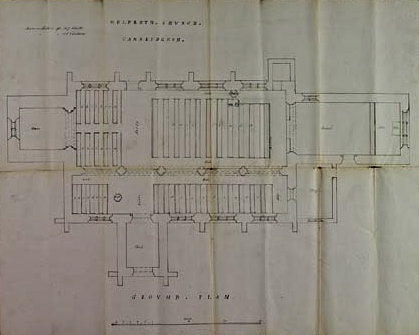Holy Trinity, Meldreth: the Nave Furnishings
Pews started to be introduced to churches from the late 13th century, but mainly during the 15th century, as a result of the increased importance of preaching. It is not known when the first pews were built in Meldreth. Whatever the form of the pews up to the early 19th century, they were replaced in 1842. Three schemes for the arrangement of new pews were submitted to the Incorporated Church Building Society (ICBS), which gave grants for such work. Interestingly, the approved scheme without a central aisle was not implemented. By the 1970s these pews were badly worm-eaten and were replaced by the present pews, which were bought from Papworth St Agnes. At some stage, possibly in the late 18th or early 19th century, a gallery was built at the west end of the nave into the opening to the tower.The gallery is not shown on the ICBS plans and must have been removed in preparation for the new pews. The gallery would have housed the wind players and the singers who accompanied the services until the introduction of organs to parish churches in the mid 19th century. A quire book from Meldreth has recently come to light.
The tiled floor may have been laid at this time, c.1840
The three ICBS plans show that alternative positions for the pulpit and the font were also being considered.
It is difficult to date the pulpit securely as it has been repaired several times. Thegeneral design, the panels and the detailing look 17th century and thus may be part of the pulpit from which John Bunyan (d.1688) preached. Its position has changed several times, most recently in 1948 when, at a cost of £50 11/3d, it was moved from the north to the south side to provide a better view of the original 15th-century door into the staircase to the screen. A scheme designed by Stephen Dykes Bower in 1948 to provide a back and a sounding board for the pulpit, to serve as a war memorial, proved too expensive.
The font is 15th century (except for the modern plinth) and must have replaced an earlier, probably 12th-century, font. Its present position dates from a recent reordering. Originally, it is likely that the font was placed in the centre of the church in line with the south entrance, its traditional position, as it marked the importance of baptism as one of the two dominical sacraments and the symbolic entry into the Church.
Also dating from the 15th or 16th century is the iron-bound parish chest. Each parish required a secure chest in which to keep the records of baptisms, deaths and, later, marriages, as parishes were the only repository of such records. Surviving parish records for Meldreth start in 1554.
In 1658 George Pike, who had acquired Sheene Manor in 1648, left £120 for his monument, which was set on the wall of his chapel built to the east of the south aisle, necessitating inserting a door in the east wall in place of the window (as is shown on the ICBS plans) and blocking of the southwest window of the chancel. The chapel fell into disuse and was finally demolished in 1887. The east window of the south aisle was then unblocked and restored and the Pike monument was moved to west end of the south aisle.
Royal arms of Queen Victoria were given by A.Hughes in 1869 and it was probably these that are recorded as beneath the tower arch in 1894. They subsequently disappeared.
The nave now has two fine brass chandeliers. One of these was originally given by William Bacon, vintner, to St Benet’s Church, Cambridge in 1725 and was acquired for Meldreth church c.1870. It is not known when the other chandelier, which dates from the 1770s, came to Meldreth.
In the churchwarden’s accounts for 1855-56 the salary of the organist is recorded as £7 p.a., and of the organ ‘blower’ as £1 p.a., so there was an organ in the church prior to the purchase of the present organ from Barrington in 1865. This was built perhaps around 1845 as a barrel organ, originally with three barrels of which two survive, with keyboard added in 1856. It was enlarged and augmented on various occasions, notably in 1944 (in memory of Georgina Martha Jebb), and most recently by Norman Hall & Sons of Cambridge in 1974. Payments to a man to work the bellows feature regularly in the churchwarden’s accounts and continued into the 1940s. The organ was placed in its present position in 1895, having originally been at the west end of the south aisle. Before the installation of organs, music was usually provided by a local wind band, which would have played in the musicians’ gallery that was recorded as being at the west end of the church. In parish churches there was often a motley collection of instruments, that might include violins, clarinets and a bassoon or serpent. Until recently, two original early 19th-century clarinets and a bassoon were displayed in the tower of Balsham parish church.
Stained glass. Fragments of 14th and 15th-century glass have been reset in the tracery lights of the north windows. In the eastern window of the south aisle is a window, probably by the nationally important workshop of Clayton and Bell, given by J.G.Mortlock on January 9th 1885 in memory of his mother and two wives.
A stone tablet Memorial to William Mortlock and members of his family hangs on the north wall.






















No Comments
Add a comment about this page